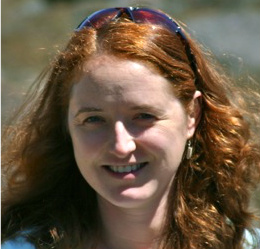
Virginia Rich is an assistant professor at Ohio State. Credit: Courtesy of Virginia Rich
An Ohio State scientist is leading an international and interdisciplinary team to study influences on climate change. She is also a mother, and, at OSU, has been able to pursue her research in a specially designed position to help keep women in research.
“Although in many scientific departments and disciplines women remain the minority, in the environmental and biological sciences women are better represented,” said Virginia Rich, assistant professor in microbiology. “And I have the great pleasure of working with a number of exceedingly accomplished women scientists throughout our project team.”
Rich is co-building the IsoGenie project along with Scott Saleska, a biogeochemist in global change from the University of Arizona. Their project studies how thawing permafrost affects climate change.
Rich started the project at the University of Arizona in 2008. A few years after she started, she gave birth to her children, which led her to the same problem that many women researchers face: the so-called “leaky pipeline” issue.
Leaky pipeline refers to the disproportionate loss of women in any given field and at each level of the scientific training process, said Matthew Sullivan, associate professor in microbiology and principle investigator of the IsoGenie project.
“Leaky pipeline is the idea that if you train a hundred men and a hundred women to be graduate students and postdocs, maybe 30 men and only five women go on to be faculty,” Sullivan said. “So the women are underrepresented at that last stage of their career track.”
The reasons for this issue can vary, but the most important one is the conflict between the critical career-building years and the biological children-bearing phase for women, Rich said.
“Because of the intensity of this career path, it can be difficult to reconcile the long hours with having and then parenting small children,” Rich said.
Luckily for Rich, she later moved to work at OSU, which is one of the few universities in the country that offers a part-time job option designed to achieve faculty diversity.
“The Ohio State University, over many years, has made it a priority to allow some flexibility for faculty, to help retain women in professor positions and in science generally,” Rich said. “This makes it a very family-friendly place.”
At OSU, Rich continues to run and lead the IsoGenie project. Compared with a normal research team with about 10 members, she coordinates an international team of approximately 35 scientists spread across institutions, like the Pacific Northwest National Lab in Washington and the University of Queensland in Australia.
Rich and her team conduct their research in Stordalen Mire, a typical permafrost zone in northernmost Sweden.
Permafrost is permanently frozen ground that covers nearly one quarter of the northern hemisphere’s landmass. It has stored around 30 to 50 percent of the world’s soil carbon and acted like a carbon freezer for more than a thousand years.
However, the global warming in recent years has melted permafrost and released carbon into the now-thawed soil, Rich said. The microbes in the soil eat the released carbon and release carbon dioxide and methane into the air, which is a process that accelerates global warming.
“A major concern in climate science has been understanding the magnitude of that acceleration,” Rich said. “We don’t really know how bad (the process) is going to be.”
To reduce that uncertainty, Rich’s team is taking a further step to study the amount of greenhouse gases the microbes produce through this process.
This year, Rich’s project received a $3.75 million grant from the U.S. Department of Energy in September. The money will be designated to support her study for the next three years.
Sullivan said it’s a challenge for scientists to interact across disciplines, because most of them are trained to be specialized. But Rich steps out and puts together the whole ecosystem picture.
“(The project) is a testament to her vision to do big, collaborative science,” Sullivan said. “She’s really been driving the connectedness of all the different disciplines and making that science big.”


